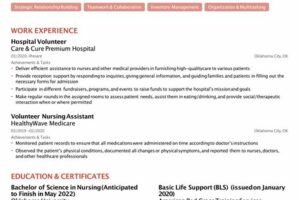Table of Contents
A volunteer EMT job description involves providing emergency medical care and transportation to individuals in need. This role requires a commitment to serving the community, strong communication skills, and the ability to handle stressful situations. Volunteer EMTs play a crucial role in saving lives and making a difference in their communities.
Are you passionate about helping others in times of emergency? Do you have a background in healthcare or emergency medical services? If so, then becoming a Volunteer EMT might be the perfect opportunity for you to make a difference in your community. As a Volunteer EMT, you will play a vital role in providing life-saving care and support to those in need. Whether it’s responding to 911 calls, administering first aid, or transporting patients to the hospital, you will be at the forefront of emergency medical response. This rewarding and challenging job requires individuals who are dedicated, compassionate, and capable of making split-second decisions under pressure. If you’re ready to put your skills to the test and help save lives, a Volunteer EMT position is waiting for you.
Introduction
Being an Emergency Medical Technician (EMT) is a rewarding and challenging career path that requires dedication, compassion, and a strong desire to help others in times of crisis. Volunteer EMTs play a crucial role in providing immediate medical care and transportation to patients in need. In this article, we will delve into the job description of a volunteer EMT, highlighting their responsibilities, skills required, and the impact they make in their communities.
Responsibilities of a Volunteer EMT
A volunteer EMT’s primary responsibility is to respond to emergency calls and provide pre-hospital care to patients. They work closely with other healthcare professionals, including paramedics and nurses, to ensure the best possible outcomes for patients. Some key responsibilities include:
- Assessing patients’ conditions and determining the appropriate course of action.
- Administering first aid and basic life support techniques, such as CPR.
- Providing immediate medical treatment and stabilizing patients before transportation to a healthcare facility.
- Operating and maintaining emergency medical equipment, such as defibrillators and oxygen tanks.
- Collaborating with law enforcement and fire department personnel at accident scenes or disaster situations.
Skills Required
Volunteer EMTs need to possess a wide range of skills to effectively perform their duties. These skills include:
- Strong communication skills to effectively interact with patients, their families, and other healthcare professionals.
- Quick decision-making abilities in high-pressure situations, often with limited information.
- Physical stamina and strength to handle the physical demands of lifting, carrying, and transporting patients.
- Ability to remain calm and composed in stressful and emotionally charged situations.
- Knowledge of medical procedures and protocols to provide appropriate care.
Training and Certification
Becoming a volunteer EMT requires completing specific training and obtaining certification. This typically involves:
- Enrolling in an accredited EMT training program, which can range from several weeks to several months.
- Completing coursework covering anatomy, physiology, medical procedures, and emergency response protocols.
- Gaining practical experience through hands-on training and supervised clinical rotations.
- Passing the National Registry of Emergency Medical Technicians (NREMT) exam to become certified.
- Maintaining certification through ongoing continuing education and skills assessments.
Working Conditions
Volunteer EMTs work in various environments, including ambulances, hospitals, and emergency scenes. They often face unpredictable and potentially dangerous situations, such as car accidents or natural disasters. The job may require working long hours, weekends, and holidays, as emergencies can occur at any time. Volunteer EMTs must be prepared to adapt to different working conditions and handle physically and emotionally demanding situations with professionalism and compassion.
Rewards and Challenges
While being a volunteer EMT can be demanding, it also offers numerous rewards. Some of these include:
- The satisfaction of directly helping people in their time of need and making a positive impact on their lives.
- The opportunity to work as part of a dedicated team of healthcare professionals and first responders.
- Continuous learning and professional development through ongoing training and exposure to diverse medical cases.
However, it is important to acknowledge the challenges faced by volunteer EMTs, such as potential exposure to contagious diseases, witnessing traumatic events, and managing emotional stress. Mental resilience and support systems are crucial in coping with these challenges and maintaining overall well-being.
Conclusion
Volunteer EMTs play a vital role in the healthcare system by providing immediate medical care and transportation to those in need. Their dedication, compassion, and quick thinking make a significant difference in saving lives and ensuring the best possible outcomes for patients. By understanding the job description, required skills, and challenges faced by volunteer EMTs, we can truly appreciate the invaluable contributions they make to their communities each day.
Volunteer EMT Job Description
As a volunteer EMT, your primary responsibility is to provide emergency medical care to individuals in need. Working closely with a team of healthcare professionals, you will assess injuries or illnesses, administer first aid and necessary treatment, and transport patients to medical facilities when required. Your availability to respond to emergency calls and provide support at community events is essential in this role.
Emergency Response Duties
One of your main duties as a volunteer EMT is to promptly respond to emergency calls, whether on-site or through dispatch, and provide immediate medical assistance to patients. This involves assessing the patient’s condition, stabilizing them, and administering appropriate medical interventions. Effective communication with other healthcare providers and accurate documentation of patient care are also crucial aspects of your role.
Patient Assessment and Care
Conducting thorough patient assessments to determine the nature and severity of injuries or illnesses is an important responsibility of a volunteer EMT. You must be able to quickly identify potential life-threatening conditions and provide appropriate interventions, such as administering CPR, controlling bleeding, immobilizing fractures, providing oxygen, and managing airways. Additionally, you should be skilled in evaluating vital signs and maintaining patient comfort and safety during transportation.
Collaboration with Healthcare Professionals
Working closely with other healthcare personnel, including paramedics, nurses, and doctors, is an integral part of being a volunteer EMT. Effective communication of patient information, relaying important updates, and following established protocols and instructions provided by higher-level medical professionals are essential for seamless patient care. Collaboration and teamwork are key in the emergency medical services field.
Documentation and Record-Keeping
Accurate documentation of patient information, medical interventions, and treatment outcomes is crucial for volunteer EMTs. You must maintain comprehensive records to facilitate continuity of care. This includes recording vital signs, medications administered, and any changes in the patient’s condition. It is also important to maintain strict confidentiality in handling patient information and adhere to legal and ethical guidelines.
Equipment Maintenance
As a volunteer EMT, you are responsible for inspecting, maintaining, and restocking medical equipment and supplies necessary for emergency response. This ensures that the equipment is in proper working condition and readily available for use during emergencies. Compliance with infection control protocols is also essential to minimize the risk of cross-contamination and maintain a safe working environment.
Community Outreach and Education
In addition to emergency response duties, volunteer EMTs play a vital role in community outreach and education. You may be involved in conducting first aid and CPR training programs, presenting at community events, or participating in health fairs to raise awareness about emergency preparedness and injury prevention. Passion for promoting public health and safety is essential in this aspect of your role.
Professional Development
As a volunteer EMT, you are encouraged to pursue ongoing professional development and training opportunities to enhance your knowledge and skills. This may include attending seminars, conferences, or workshops, as well as staying informed about the latest advancements in emergency medicine. Striving to stay up-to-date with industry standards and best practices will enable you to provide optimal care to patients.
Note: The above information provides a generic description of a volunteer EMT job. Specific job duties and responsibilities may vary based on regional regulations, organizational policies, and the level of EMT certification.
A volunteer EMT (Emergency Medical Technician) plays a crucial role in providing immediate medical assistance to individuals in need. With a strong sense of dedication and compassion, these professionals willingly offer their time and skills to serve their communities during emergencies. The job description of a volunteer EMT comprises several key responsibilities that require professionalism, expertise, and effective communication.
1. Providing emergency medical care: As a volunteer EMT, the primary duty is to administer emergency medical care to patients in various settings. This includes assessing the patient’s condition, monitoring vital signs, and administering appropriate first aid or life-saving techniques.
2. Responding to emergency calls: Volunteer EMTs are on-call and ready to respond to emergency calls at any time. They must promptly arrive at the scene, assess the situation, and provide necessary medical assistance. This may involve stabilizing patients, immobilizing injuries, or initiating basic life support measures.
3. Collaborating with other healthcare professionals: Volunteer EMTs work closely with other healthcare professionals, such as paramedics, firefighters, and police officers. They must effectively communicate and coordinate efforts to ensure seamless patient care and transport.
4. Maintaining equipment and supplies: It is the responsibility of a volunteer EMT to keep medical equipment and supplies organized, clean, and readily available. This includes regularly checking and restocking medical kits, ensuring the functionality of equipment, and reporting any deficiencies or issues.
5. Documenting patient information: Accurate documentation is essential in emergency medical situations. Volunteer EMTs are required to maintain detailed records of patient assessments, treatments provided, and other relevant information. This ensures continuity of care and assists medical professionals in subsequent treatments.
6. Participating in training and education: Volunteer EMTs must actively participate in ongoing training and educational programs to stay updated with the latest medical protocols and techniques. This includes attending regular meetings, workshops, or seminars to enhance their skills and knowledge.
7. Upholding ethical and professional standards: Volunteer EMTs are expected to uphold high ethical and professional standards at all times. They must maintain patient confidentiality, provide non-judgmental care, and act in accordance with established medical guidelines and legal regulations.
In conclusion, a volunteer EMT job description entails a range of responsibilities that require a professional voice and tone. These individuals serve as essential first responders, providing critical medical care during emergencies. By adhering to their job description and embodying professionalism, volunteer EMTs contribute significantly to the well-being and safety of their communities.
Thank you for taking the time to visit our blog and learn more about the volunteer EMT job description. We hope that the information provided has been helpful in giving you a comprehensive understanding of what it takes to be a volunteer EMT and the responsibilities that come with this noble role.
As discussed in the previous paragraphs, being a volunteer EMT requires dedication, compassion, and a strong sense of responsibility. It is a role that demands quick thinking, excellent communication skills, and the ability to remain calm in high-pressure situations. By choosing to become a volunteer EMT, you are making a selfless commitment to serving your community and saving lives.
Volunteering as an EMT can be an incredibly rewarding experience. Not only will you have the opportunity to make a real difference in the lives of those in need, but you will also gain invaluable skills and knowledge that can benefit you both personally and professionally. The hands-on experience you will gain as a volunteer EMT can open doors to various career paths in the medical field, should you choose to pursue them.
If you are considering becoming a volunteer EMT, we encourage you to reach out to your local emergency medical services or fire department. They can provide you with more information on how to get started, training requirements, and any specific qualifications they may be looking for. Remember, becoming a volunteer EMT is a commitment, and it is essential to thoroughly understand the responsibilities and expectations before embarking on this journey.
We appreciate your interest in learning more about the volunteer EMT job description, and we hope that this blog has given you valuable insights into this crucial role. Whether you decide to pursue a career as an EMT or not, we applaud your desire to make a positive impact in your community. Thank you for your time, and we wish you the best in all your future endeavors!
.
People also ask about Volunteer EMT Job Description:
1. What are the main responsibilities of a Volunteer EMT?
A Volunteer EMT is responsible for providing emergency medical care to individuals in need. They respond to 911 calls or other emergencies, assess the patient’s condition, administer first aid and CPR if required, and transport patients to medical facilities.
2. Is any prior experience or certification required to become a Volunteer EMT?
Prior experience or certification in emergency medical services is typically required to become a Volunteer EMT. This may include completing an EMT training program, obtaining a state-issued EMT certification, and maintaining CPR certification.
3. What skills are essential for a Volunteer EMT?
Essential skills for a Volunteer EMT include strong communication abilities to effectively interact with patients and other medical professionals, critical thinking skills to make quick decisions in emergency situations, physical stamina to handle physically demanding tasks, and the ability to remain calm and composed under pressure.
4. How many hours do Volunteer EMTs typically work?
The number of hours worked by Volunteer EMTs can vary depending on their availability and the requirements of the specific organization they volunteer for. Some volunteers may commit to set shifts or specific hours each week, while others may be on-call and respond to emergencies as needed.
5. Are Volunteer EMTs entitled to any benefits?
As volunteers, EMTs typically do not receive monetary compensation or benefits. However, they gain valuable experience, training, and personal satisfaction from helping others in need.






